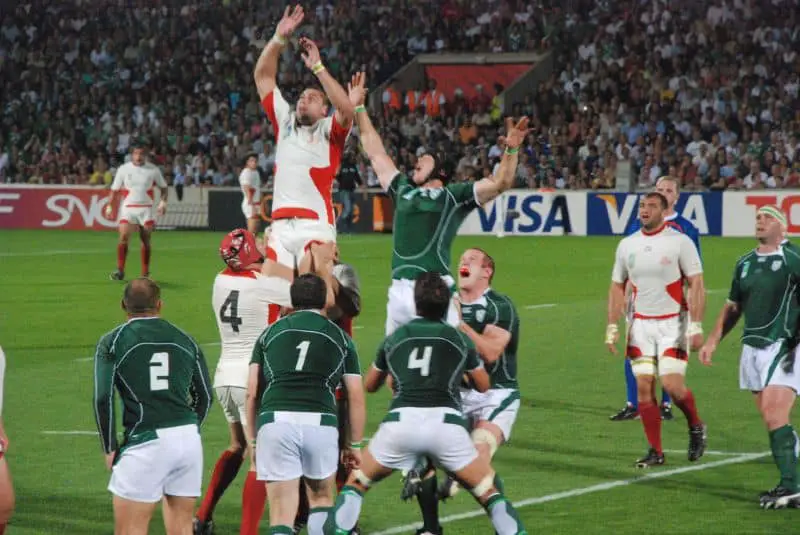Have you noticed that rugby players sometimes put their hands up? Whether they are in a ruck or on the field, some rugby players raise their hands for apparently no reason. So why do rugby players put their hands up?
A rugby player most commonly puts his hand up to show that they are in the ‘pillar’ position which means that they are guarding the side of a ruck. A further common reason is when a player wants to indicate that they aren’t disrupting a movement when in an offside position, and therefore should not be penalised.
While there isn’t always an apparent reason for a rugby player putting his hands in the air, this can happen in several defined scenarios. We ae goint to explore each situation to understand better what a rugby player is indicating by raising his hands during a game.
Why Do Some Rugby Players Put Their Hands Up?
There are four obvious reasons why rugby players sometimes raise their hands. The rules don’t state that rugby players must raise their hands at any game stage. However, they often do this to indicate something to the referee or other players. Here are four possible reasons a rugby player would put his hands up during a game.
1. Indicating Your Position
Some rugby players will put their hands up to indicate their position to other players. For example, this often happens during a ruck when one player indicates that he is in the pillar position. A pillar is the first line of defense immediately to the side of a ruck.
This is a crucial position that must be filled, as the opponents often break through the defense if the pillar is not in position. Therefore, one player will take the pillar position and may raise his hands to signify that he is in position and ready to defend the line.
2. Showing That You Are Not Playing
Another reason rugby players often put their hands up is to show the referee that they aren’t actively participating in a play. This often happens when a player find themselves offside and cannot catch the ball or make a tackle from his current position.
Furthermore, a tackled player may put his hands up to indicate that he has released the ball and is trying to roll away from it. Rolling away isn’t always as easy as it sounds. Therefore, by raising his hands, the referee can see that the player isn’t holding onto the ball and is attempting to move away from it.
Suggested reading: What Are Rugby Rules For Hand-offs (Tips And Tricks)
3. Contesting A Ball
Another reason you may notice a rugby player is putting his hands up is when he is contesting a ball. This can be in a lineout when the other team has possession of the ball or when one player kicks the ball and another is contesting to catch it.
In this case, the raised hand doesn’t indicate anything to the referee or team members. Instead, it is simply because the player attempts to intercede the ball and grab it from his opponent.

4. Expressing Emotion
A rugby player can also raise his hands to show emotion. For example, if a player is tired or upset, he can raise his hands to show his frustration or get some air while breathing. But, again, this doesn’t indicate anything to his teammates. Instead, it is a gesture that doesn’t carry much value within the game’s structure.
5. To Charge Down A Kick
There are many occassion during a game when an opponent may wish to charge down a kick, i.e. block the path of the ball immediately as it leaves a players boot. Typically, this happens at the side of a ruck when a scrum-half is attempting to box kick the ball, or when a fly-half is trying to kick the ball down field to gain territory.
6. To Signal For A Cross-kick
In recent years players have become mroe proficient at kicking the ball across the pitch to a team mate who is in lots of space near the opponents try line.
To get the fly halfs attention, the person who would normally be in position to cross kick the ball, they would raise both hands and wave them franticall to signal for the cross kick.
7. To Compete In The Lineout
As you can see, there are quite a few reasons why rugby players raise their hands during a game. For example, it can indicate their position on the field, show that they aren’t involved in a play, or when contesting for the ball in a lineout. Furthermore, a player can also put his hands in the air to show emotion.
Suggested reading: Why Rugby Players Wear Tape
Image Credits
16 October 2011, 15:23 jeanfrancois beausejour from cannes, france, CC BY 2.0, via Wikimedia Commons
Ireland vs Georgia, Rugby World Cup 2007. Stade Chaban Delmas, Bordeaux, France. Line-out for Georgia M+MD, CC BY-SA 2.0, via Wikimedia Commons
